
Trillium is a genus of about fifty flowering plant species in the family Melanthiaceae. Trillium species are native to temperate regions of North America and Asia, with the greatest diversity of species found in the southern Appalachian Mountains in the southeastern United States.

Trillium erectum, the red trillium, also known as wake robin, purple trillium, bethroot, or stinking benjamin, is a species of flowering plant in the family Melanthiaceae. The plant takes its common name "wake robin" by analogy with the European robin, which has a red breast heralding spring. Likewise Trillium erectum is a spring ephemeral whose life-cycle is synchronized with that of the forests in which it lives. It is native to the eastern United States and eastern Canada from northern Georgia to Quebec and New Brunswick.
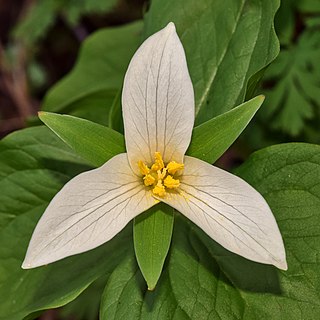
Trillium ovatum, the Pacific trillium, also known as the western wakerobin, western white trillium, or western trillium, is a species of flowering plant in the family Melanthiaceae. It is found in western North America, from southern British Columbia and the tip of southwestern Alberta to central California, east to Idaho and western Montana. There is an isolated population in northern Colorado and southern Wyoming.

Trillium catesbaei, also known as bashful trillium, Catesby's trillium, or bashful wakerobin, is a species of flowering plant in the family Melanthiaceae. It is found in the southeastern United States where its northern limit includes the Great Smoky Mountains and other parts of North Carolina and Tennessee. Its southernmost natural occurrence is in Escambia County, Alabama. Most of its populations are in the Piedmont from North Carolina to Alabama, under deciduous trees such as American beech, various oak and hickory species, and tulip poplar. Like most trilliums, it prefers moist, humus-rich soil in shade.

Trillium luteum, the yellow trillium or yellow wakerobin, is a species of flowering plant in the bunchflower family Melanthiaceae with native populations in the Great Smoky Mountains of the United States and surrounding areas.

Trillium rugelii, also known as the southern nodding trillium or illscented wakerobin, is a species of flowering plant in the family Melanthiaceae. It is native to parts of the southeastern United States. It is found in the Great Smoky Mountains, Fernbank Forest, Steven's Creek Heritage Preserve, and other places of the Piedmont and southern Appalachian Mountains in Alabama, Georgia, South Carolina, North Carolina and Tennessee. It prefers to grow near streams in humus-rich soil under the shade of deciduous trees.

Trillium discolor, the mottled wakerobin, pale yellow trillium, or small yellow toadshade, is a species of flowering plant in the family Melanthiaceae. It is native to areas of the Savannah River drainage system of Georgia, North Carolina and South Carolina such as Steven's Creek Heritage Preserve and Lake Keowee. It is found along moist stream banks in upland woods, on acidic to basic soils.

Trillium flexipes, known as the nodding wakerobin, bent trillium, or drooping trillium, is a species of flowering plant in the family Melanthiaceae. It is found from Minnesota to Ohio, south to Tennessee, with isolated populations in New York, Pennsylvania, Alabama, and other states. It is an endangered species in Ontario and possibly extirpated in North Carolina.

Trillium viridescens, also known as the Ozark trillium or tapertip wakerobin, is a species of flowering plant in the family Melanthiaceae. It is found in parts of Arkansas, Missouri, Oklahoma, Kansas, Texas and Louisiana. It usually grows in rich deciduous forests and mountain ranges where the soil is clayey and calcareous.
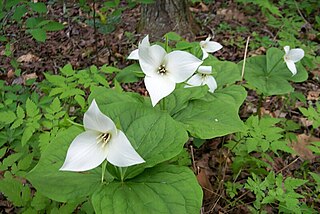
Trillium simile, the jeweled wakerobin, is a spring-flowering perennial plant which is native to southern parts of the Appalachian Mountains in southeastern United States. It is also known as sweet white wake-robin, sweet white trillium and confusing trillium.

Trillium decipiens, also known as Chattahoochee River wakerobin or deceiving trillium, is a spring-flowering perennial plant. It occurs mostly near the Chattahoochee River in Alabama, Florida and Georgia. Scattered populations are found elsewhere in these three states, all within the Atlantic Coastal Plain or Gulf Coastal Plain. Rich deciduous woods of bluffs, ravines, and alluvial land provide its most favored habitat.

Trillium nivale, the snow trillium or dwarf white trillium, is a species of flowering plant in the family Melanthiaceae. It is native to parts of the east and midwest United States, primarily the Great Lakes States, the Ohio Valley, and the Upper Mississippi Valley, as far north as central Minnesota.

Trillium vaseyi, the sweet wakerobin or sweet beth, is a spring flowering perennial plant which is found only in the southeastern United States, primarily in the southern part of the Appalachian Mountains but with a few populations farther south.
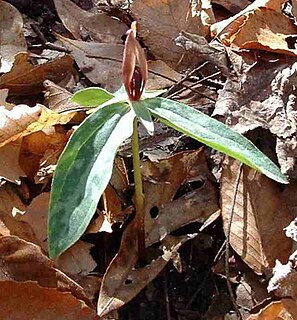
Trillium lancifolium, the lanceleaf wakerobin, lance-leaved trillium, or narrow-leaved trillium, is a species of plants native to the southeastern United States. It is known to occur in Alabama, Florida, Georgia, Mississippi, South Carolina, and Tennessee. The species is imperiled in Alabama and Florida, and critically imperiled in South Carolina and Tennessee.
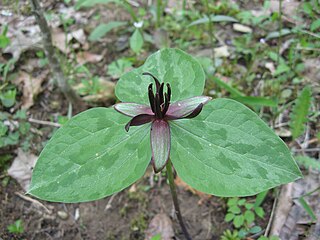
Trillium stamineum, the twisted trillium, also known as the Blue Ridge wakerobin, is a species of flowering plant in the family Melanthiaceae. It is native to the southeastern United States, in Alabama, Mississippi and Tennessee. Its natural habitat is calcareous woodlands.

Trillium sulcatum, the furrowed wakerobin, southern red trillium or Barksdale trillium, is a perennial wildflower that blooms in April and May. It is native to the southern Appalachian Mountains and nearby areas from West Virginia to Alabama.

Trillium pusillum is a species of flowering plant in the family Melanthiaceae known by the common names dwarf trillium, least trillium and dwarf wakerobin. It is native to the southeastern and south-central United States from Oklahoma to Maryland.

Trillium gracile, commonly known as the Sabine River wakerobin, slender trillium, or graceful trillium, is a species of flowering plant in the family Melanthiaceae. It is native to the region along the Sabine River in western Louisiana and eastern Texas. It generally grows in mature pine and hardwood forests, and on riverbanks.
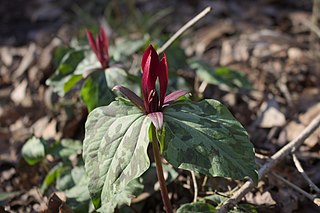
Trillium maculatum, the spotted wakerobin or spotted trillium, is a species of flowering plant in the family Melanthiaceae. It is found only in the eastern United States.

Trillium ludovicianum, the Louisiana wakerobin or Louisiana trillium, is a species of flowering plant in the family Melanthiaceae. It is found only in the south-central United States, in Louisiana, Mississippi, and eastern Texas.




















